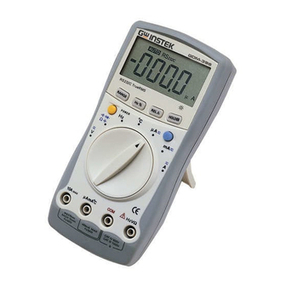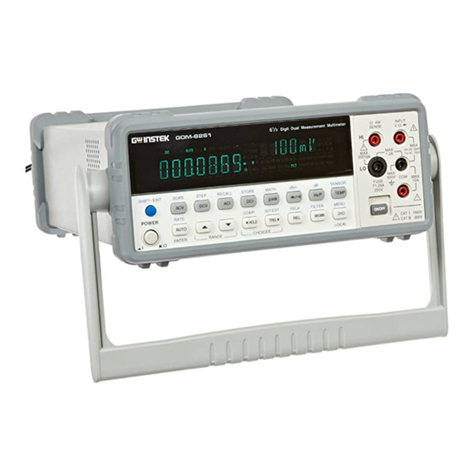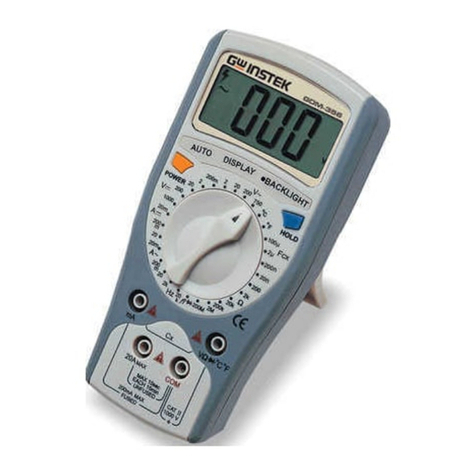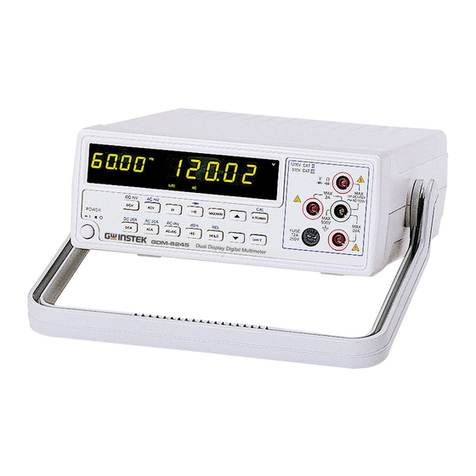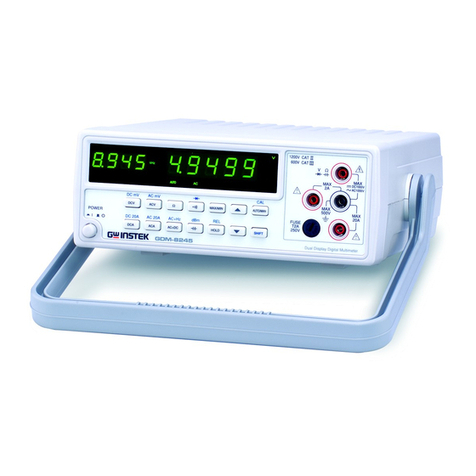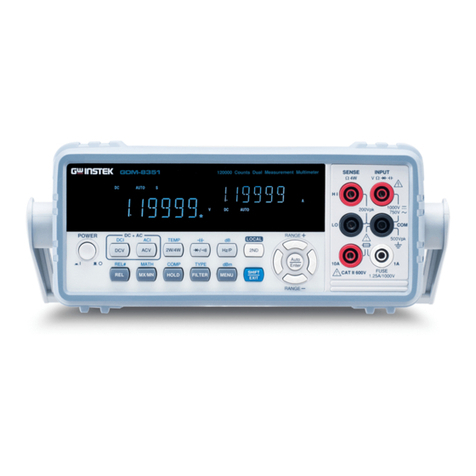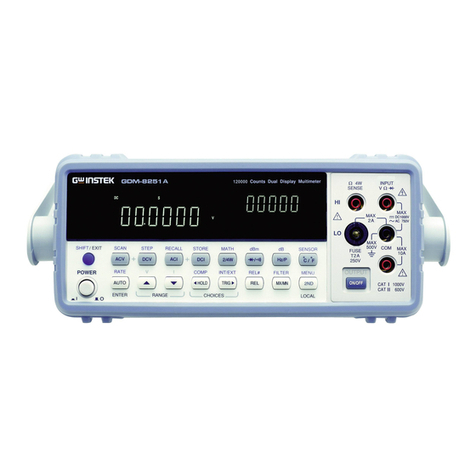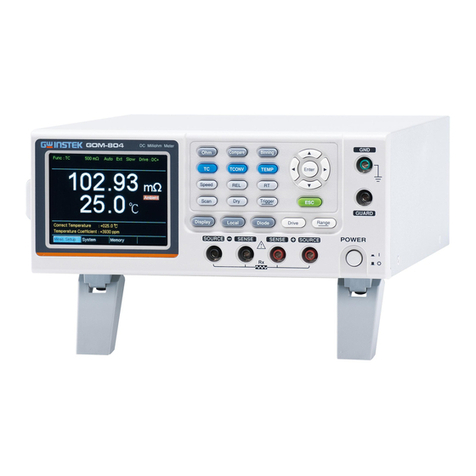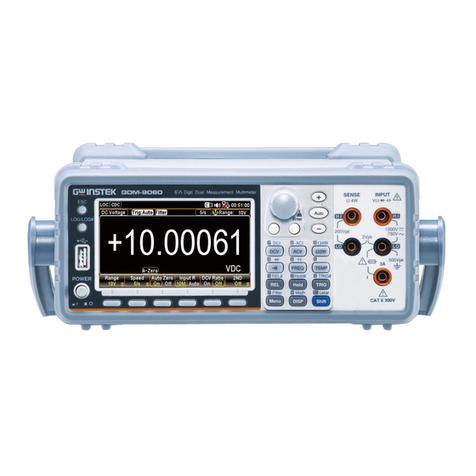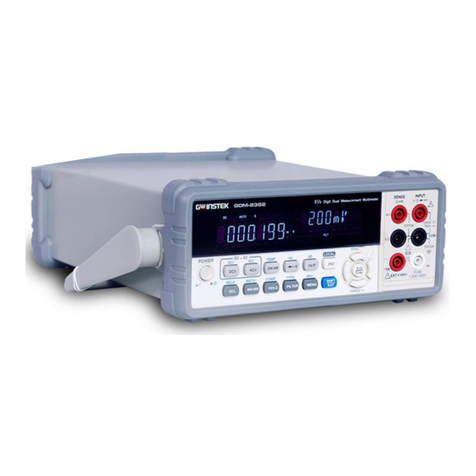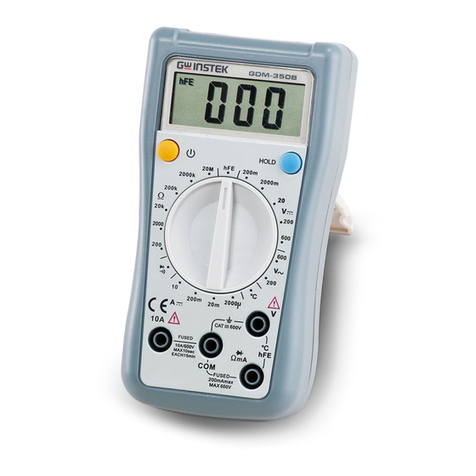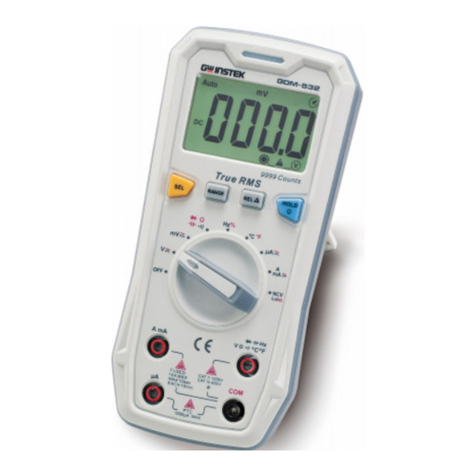Resistance measurement (Ω) (See Figure 5)
Warning: Be sure to turn off circuit power and
discharge residual charge from all capacitors
before connecting a load.
•Set the dial: Turn the measurement function dial
to “ ”.
•To select key functions:The
clamp meter defaults to Ω
and auto-ranging mode.
Press REL to access
the relative mode.
•Connect the load.
•For best measurement
results separate the resistive
element from the circuit. After
all measurement operations,
disconnect the probe and the
measured circuit and then
remove the probe from input end.
4. Diode measurement ( ) (See Figure 6)
Warning: Be sure to turn off circuit power and
discharge residual charge from all capacitors
before connecting a load.
•Set the dial. Turn the
measurement function dial to
“ ”.
•Select functions: Select
diode by pressing the
SELECT key;
•Connect the load.
•For best measurement results
separate the diode from the
circuit.
•After all measurement
operations, disconnect the probe
from the measured circuit then remove the probe
from the clamp inputs.
5. Continuity Test ( ) (See Figure 7)
Warning: Be sure to turn off circuit power and
discharge residual charge from all capacitors
before connecting the load.
•Set the dial. Turn the
measurement function dial to
“ ”.
•Select continuity by
pressing the SELECT
key.
•Connect to the load.
•The Buzzer will beep if the
measured resistance is less
than10Ω. It will not beep if the
measured resistance exceeds
10Ω.
•After all measurement operations,
disconnect the probe from the measured circuit
then remove the probe from the clamp inputs.
6. Capacitance measurement( )(See Figure 8)
Warning: Be sure to turn off circuit power and
discharge residual charge from all capacitors
before connecting the load.
•Set the dial. Turn the
measurement function dial to
“ ”.
•Select capacitance by
pressing the SELECT
key.
•Connect the load.
Measurement notice:
1)Be sure to reset the unit by
pressing the REL key before
measurement.
2)The instrument reading normally
will be delayed by about 30 seconds when
measuring large capacitances.
•After all measurement operations, disconnect the
probe from the measured circuit then remove the
probe from the clamp inputs.
7.Frequency measurement (Hz) (See Figure 9)
Warning: The clamp meter cannot be used for
conductors which exceed AC/DC 600V.
•Set the dial. Turn the measurement function dial
to “Hz”.
•Connect to the load.
•After all measurement
operations, disconnect the
probe from the
measured circuit then
remove the probe from
the clamp inputs.
VI. Display Symbols(See Figure 2)
1. Indicator for AC Measurement;
2. Indicates negative polarity;
3. Indicator for DC Measurement;
4. Low Battery Indicator;
5. Auto-Ranging Mode;
6. Indicator for Diode Test;
7. Indicator for Continuity Test;
8. Data Hold is Active;
9. Indicator for Relative Measurement;
10. Temperature Unit (ºC);
11. Resistance Units (Ω, kΩ and MΩ);
12. Frequency Units (Hz);
13. Capacitance Units (nF and µF);
14. Current Unit (A);
15. Voltage Units (mV and V);
VII. Key Functions and Automatic
Shutdown
1.HOLD
This function maintains the displayed reading on
the LCD display. The displayed value will be
locked on the display by pressing the key once. It
can be pressed again to release locking state
and return to the common measurement state.
2.REL
Press down the key to use current reading as the
reference value and reset the display to "0". This
reference value is subtracted every time from
measuring results until you press the key again
to exit the mode.
power and discharge all capacitors before
measuring resistors, diodes or circuits.
Disconnect the probes and the measured
circuit, then remove the probes from clamp
meter inputs and lastly turn off the power after
measurement.
8. Replace the battery when“ ” shows on the
LCD to ensure the measuring accuracy.
Remove the battery if the clamp meter has not
been used for a long time.
9. Please do not alter the internal wiring of the
clamp meter randomly to avoid instrument
damage and jepodise safety.
10.Do not store or use the clamp meter in an
environment with high-temperature,
high-humidity, flammables, explosives or strong
current magnetic fields.
11.Clean the instrument case with a soft cloth and
neutral detergent during maintenance. Do not
use abrasives or solvents to avoid case
corrosion which may cause damage to the
clamp meter or cause personal injury.
Note: When the REL function is turned on in ACV,
Ω or DCV measurement modes, the meter locks
the range to the current measurement range.
Therefore, after turning off the REL function, you
need to push the SELECT key or set the function
dial to another position to manually restore the
auto-range function.
When the displayed reading shows “OL” in Ω,
diode or continuity measurement modes, the REL
function may not be turned on or off. To switch on
or off the REL function with these functions, first
short the test leads or connect the test leads to a
DUT so as to prevent the “OL” state occuring.
3.SELECT
Used to switch between
Note: Automatic shutdown function will be
cancelled if the SELECT key is pressed to wake
up the meter from the sleep mode.
4.Automatic Shutdown
The clamp meter will “power off automatically”
(under sleep mode) to save electric energy if the
function key or the measurement function dial are
not used within 15 minutes during measurement.
The clamp meter will start up automatically
(under working mode) by rotating the measure-
ment function dial under automatic shutdown
mode. (Please refer to Item 6 for valid key function
operations.)
Note: The automatic shutdown function will be
cancelled by pressing the SELECT key to wake-up
the unit from the sleep mode.
5.Buzzer
The buzzer will beep when any effective function
key is pressed under any measurement range. It
will not beep if the key is invalid. The buzzer will
issue 5 warning beeps continuously for about 1
minute before automatic shutdown. It will also
issue a long beep before power off.
6.Valid Key Functions
Not all functions are valid under any range. As
indicated below, the corresponding functions or to
wake up the meter can be achieved only when the
keys are valid.
VIII. Measurement Instructions
1. DC voltage measurement ( ) (See Figure 3)
Warning: The clamp meter cannot be used with
conductors that exceed AC/DC 600V.
•Set the dial: Turn the measurement function dial
to “ ”.
•Select key functions: The
clamp meter defaults to DC
Voltage and auto-ranging
mode. Press REL to
access the relative
mode.
•Connect to the load.
•Disconnect the probe
from the measured circuit then
remove the probe from the
clamp inputs after all measurement
operations.
2. AC voltage measurement ( ) (See Figure 4)
Warning: The clamp meter cannot be used for
conductors which exceed AC/DC 600V.
•Set the dial: Turn the measurement function dial
to “ ”.
•To select key functions: Press
the SELECT button to select
AC voltage mode. It defaults
to auto-ranging. Press REL
to access relative mode.
•Connect to the load.
•Disconnect the probe
from the measured circuit then
remove the probe from the
clamp inputs after all
measurement operations.
Warning
I.Overview
IV.Electrical Symbols
Double Insulated
AC
Diode
Warning prompt
ACor DC
To meet European Union standard.
Grounding
DC
Low battery Indication
Buzzing ON/OFF
3
4
6 9 10
12
11
58
14
1
2
15
7
13
Figure 2
△
△
△
Figure 8
1 pc
1 pair
1 pc
1.
2. Test Probes
3. Temperature probe
Operating Manual
GCM-403
Please read this manual, the “Safety Information”
and warnings carefully before using the meter.
The GCM-403 is a 4000-count AC/DC digital clamp
meter with stable performance and a high degree of
safety and reliability. It is designed with large-scale
integrated circuits and dual integrating A/D
converters as its core. It has overload protection for
all ranges and a novel design, which makes it a
superb tool for electricians. The meter can measure
AC/DC voltage, AC/DC current, resistance, diodes,
continuity, capacitance, frequency and temperature.
II. Unpacking Inspection
Please open the package box and take the
instrument out. Please check if the following items
are missing or damaged.
Please contact your supplier straight away if any
item is missing or damaged.
III. Safety Information
The instrument is designed and manufactured in
compliance with GB4793, IEC61010-1 and IEC
1010-2-032: Double Insulation, Overvoltage CAT
Ⅱ600V & CATⅢ 300V and Pollution Degree 2.
A Warning identifies conditions and actions that
may pose hazards to the user, or cause damage to
the meter or equipment under test. Please pay
attention to warnings and use the meter as
specified as below, otherwise you may impair the
protection offered by the clamp meter.
1. Please inspect the clamp meter and test leads
before use to avoid damage or abnormal use.
Please do not use the clamp meter again if the
test leads or case insulation is damaged, the
LCD display has failed or the clamp meter
cannot operate normally.
2. It is strictly prohibited to use the clamp meter
without covering the rear cover and/or the
battery cell to avoid electric shock.
3. Fingers cannot exceed past the probe’s finger
guard during measurement. To avoid electric
shock, do not touch naked electric wires,
connectors, exosed inputs or circuits during
measurement.
4. The measurement function dial must be in the
correct position before measurement. Do not
change ranges during measurement to avoid
damaging the clamp meter.
5. Do not exert more than 600V between the clamp
meter terminal and ground to avoid electric
shock or damage to the clamp meter.
6. To avoid electric shock, operate the instrument
carefully under DC 60V or AC 30V.
7. Do not measure voltage or current which is
greater than the allowable input levels. Be sure
to set the function range switch to the highest
range possible if the magnitude of the measured
value is unknown. Be sure to turn off the circuit
Key
Hz
SELECT
N/A N/A
N/A
REL HOLD
V
Figure 3
V
~
~
Figure 4
Figure 5
Figure 6
Figure 7
△
V. The Meter Structure (See Figure 1)
1. Input end;
2. LCD digit display;
3. Functions key: To select basic
functions;
4. Measurement Function dial:
The grey function icons are
the initial functions; The blue
function icons are selected after
pressing the blue SELECT key;
5. Clamp head trigger: Press the
trigger to open the clamp head.
The clamp head will close again if
the trigger is released;
6. Hand protection: It prevents users from touching
any dangerous areas.
7. Clamp head: It is a device to measure AC/DC
current and converts the current to voltage. A
single conductor of the measured current must
pass perpendicularly through center of the clamp
head.
Figure 1
Hz
Figure 9
1
2
5
7
6
4
3

